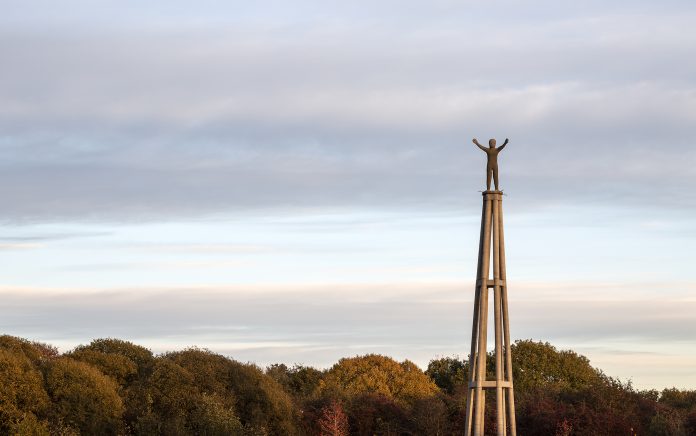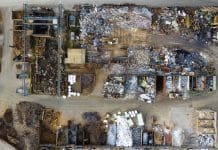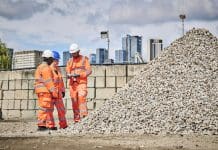The Hope Sculpture by Steuart Padwick officially launched in Glasgow, with an industry panel discussing how the build’s 75% reduction in CO2 can be used to accelerate the construction sector’s net zero delivery
The Hope Sculpture is the UK’s first permanent superstructure constructed from 100% cement-free concrete and incorporates locally sourced aggregates and recycled crushed glass.
Designed by Steuart Padwick in collaboration with over 50 industry leaders, the public art installation across 3 sites in Glasgow is an official COP26 legacy project.
The main sculpture is located in Cuningar Loop Woodland Park within Clyde Gateway, Scotland’s largest urban regeneration project, with all those involved in the project working to achieve the build in record time.
Alongside using cement-free concrete, the reduction in emissions was achieved through a combination of reclaimed materials such as steel glass pipes and offsite construction methods to reduce waste and increase efficiencies.
The two further sculptures are at Glasgow Central Station and University of Strathclyde. The first sculpture is constructed from contoured layers of sustainably grown Scottish Sitka Spruce, and the second is from reclaimed sheet steel with a low carbon 100% cement-free concrete foundation.
Post-COP26, the Hope Sculpture provides a showcase of how the construction industry can help drive the UK net-zero transition through innovative design and construction approaches.
As the built environment contributes to over 40% of the UK’s carbon emissions, the project has enabled all partners to gather valuable data and insight into future approaches for the construction sector.
The launch was attended by many industry leaders and included an expert industry panel led by Dr. Roddy Yarr Executive Lead for Sustainability at the University of Strathclyde.
The panellists included Alan Dowdall, building director and low carbon design expert at Ramboll, Jasen Gauld, technical sales director at Aggregate Industries – London Concrete, Neil McKay, managing director at regeneration contractor Urban Union, and Michael O’Hagan, managing director for built environment at Keltbray.
The panel discussed how they achieved the Hope Sculpture’s 75% carbon reduction, and it’s potential to provide a ‘watershed moment’ for low carbon construction of the future, as well as the changes needed in the construction and built environment sectors to accelerate net-zero delivery.
‘Embracing a future of hope’
Upon the unveiling of the installations, Padwick commented: “We all need to address this new global agenda so our young can embrace a future of hope. It is very simple, why would anyone want to poison their future?
‘A truly collaborative industry effort’
Alan Dowdall, building director and low carbon design expert at Ramboll, commented: “Reducing the carbon impact of the construction sector is no longer a ‘nice to have’ but a must-have, and innovation is essential in achieving this. The sculptures are an example of just how much can be achieved through a truly collaborative industry effort, and it is now up to us to take these lessons forward and drive sustainable change.”
The Hope Sculpture will serve as a beacon of hope and positivity towards reaching global environmental milestones and a reminder of the key role the construction industry has to play in driving the net-zero transition.
The sculptures
The Hope Sculpture is a 23.5m high installation made using low carbon, recycled and sustainable materials, located in the woodland park of Cuningar Loop, and a part of Clyde Gateway, Scotland’s largest regeneration programme.
The sculpture features an age, gender, race neutral child, embracing the surrounding nature and reaching out to a greener, hopeful future.
It stands upon towering elegant 20m high columns, taking their form from Glasgow’s traditional brick chimney stalks but made from an innovative new low-carbon 100% cement free concrete, the UK’s first permanent, cement free concrete superstructure, which paves the way for this pioneering solution.
The lighting is soft low energy and respectful of the environment and of local wildlife, using fittings designed and manufactured in Scotland for the Circular Economy.
The 4.5m high Beacon of Hope is located at the city’s architecturally significant Glasgow Central Station, with the Child of Hope reaching out to all those passing through the station.
The sculpture is made from contoured layers of sustainable Scottish-grown Sitka Spruce, and celebrates the expanding timber construction industry that Scotland is developing.
![]()
Finally, the 3.5m high Hope Triptych at the University of Strathclyde’s Rottenrow Gardens is a playful adaptation of the Child of Hope and composed of three colourful figures, symbolising the power of coming together.
The Hope Triptych is made from reclaimed sheet steel with a low carbon 100% cement-free concrete foundation.
As well as highlighting the possibilities of sustainability, the sculptures aim to link the environment with mental well-being, and each carries mental health signposting nearby in association with the Mental Health Foundation.














